FIN3002S - Treasury and Risk Management - Currency Risk Analysis
VerifiedAdded on 2023/06/15
|14
|2539
|287
Report
AI Summary
This report provides an analysis of treasury and risk management, specifically focusing on hedging measures used by exporters and the reasons behind the de-pegging of the Swiss Franc. It evaluates different hedging strategies, including unhedged, forward hedge, money market hedge, and option hedge, to determine the most optimal approach for ABC Company in managing currency conversion risks. The report also discusses the implications of the Swiss National Bank's decision to de-peg the Swiss Franc and the impact on the Swiss economy. Ultimately, the money market hedge is identified as the most viable strategy for ABC Company due to its ability to provide a balance between risk mitigation and profit potential. Desklib offers a range of solved assignments and past papers for students seeking further assistance.
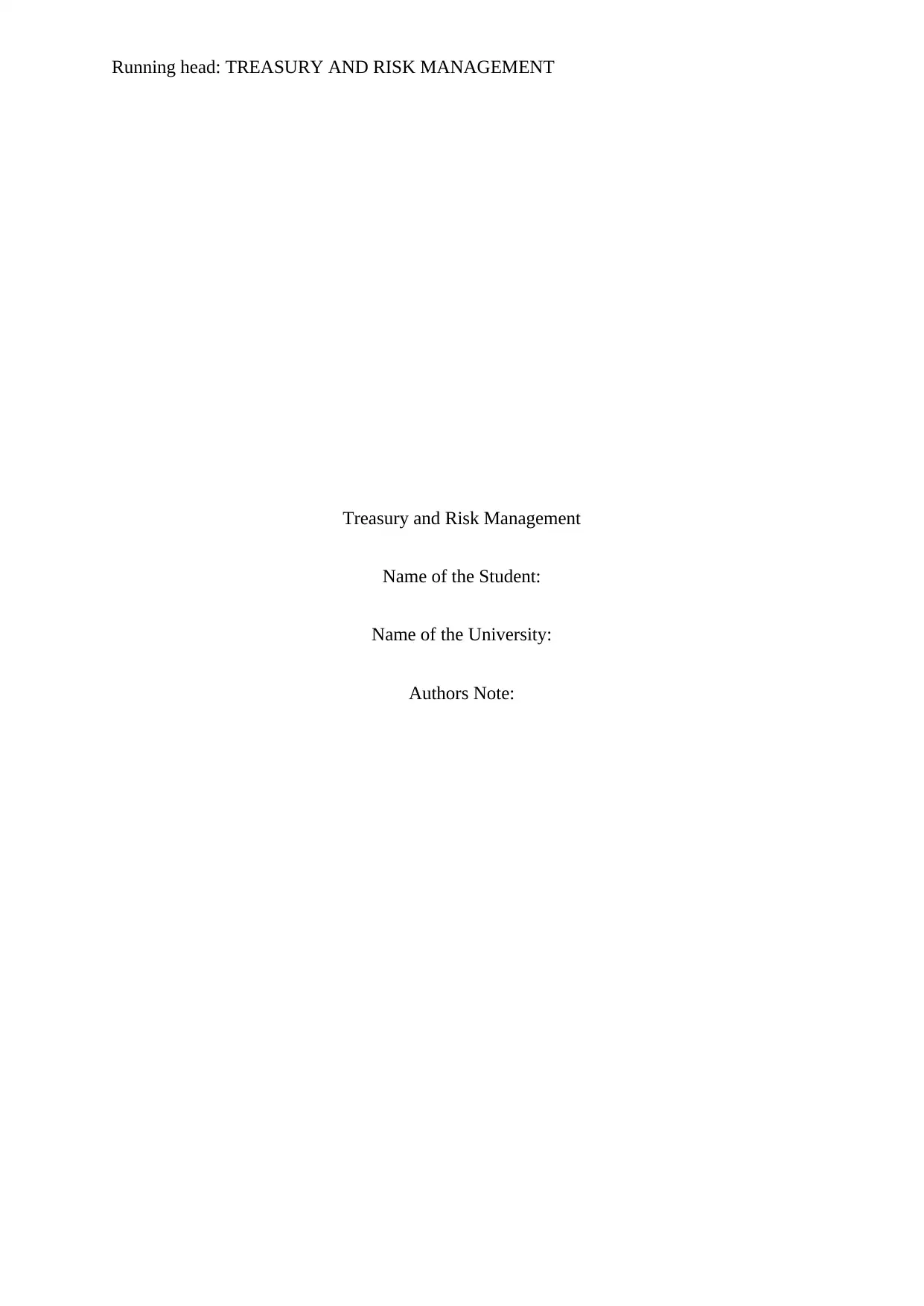
Running head: TREASURY AND RISK MANAGEMENT
Treasury and Risk Management
Name of the Student:
Name of the University:
Authors Note:
Treasury and Risk Management
Name of the Student:
Name of the University:
Authors Note:
Paraphrase This Document
Need a fresh take? Get an instant paraphrase of this document with our AI Paraphraser
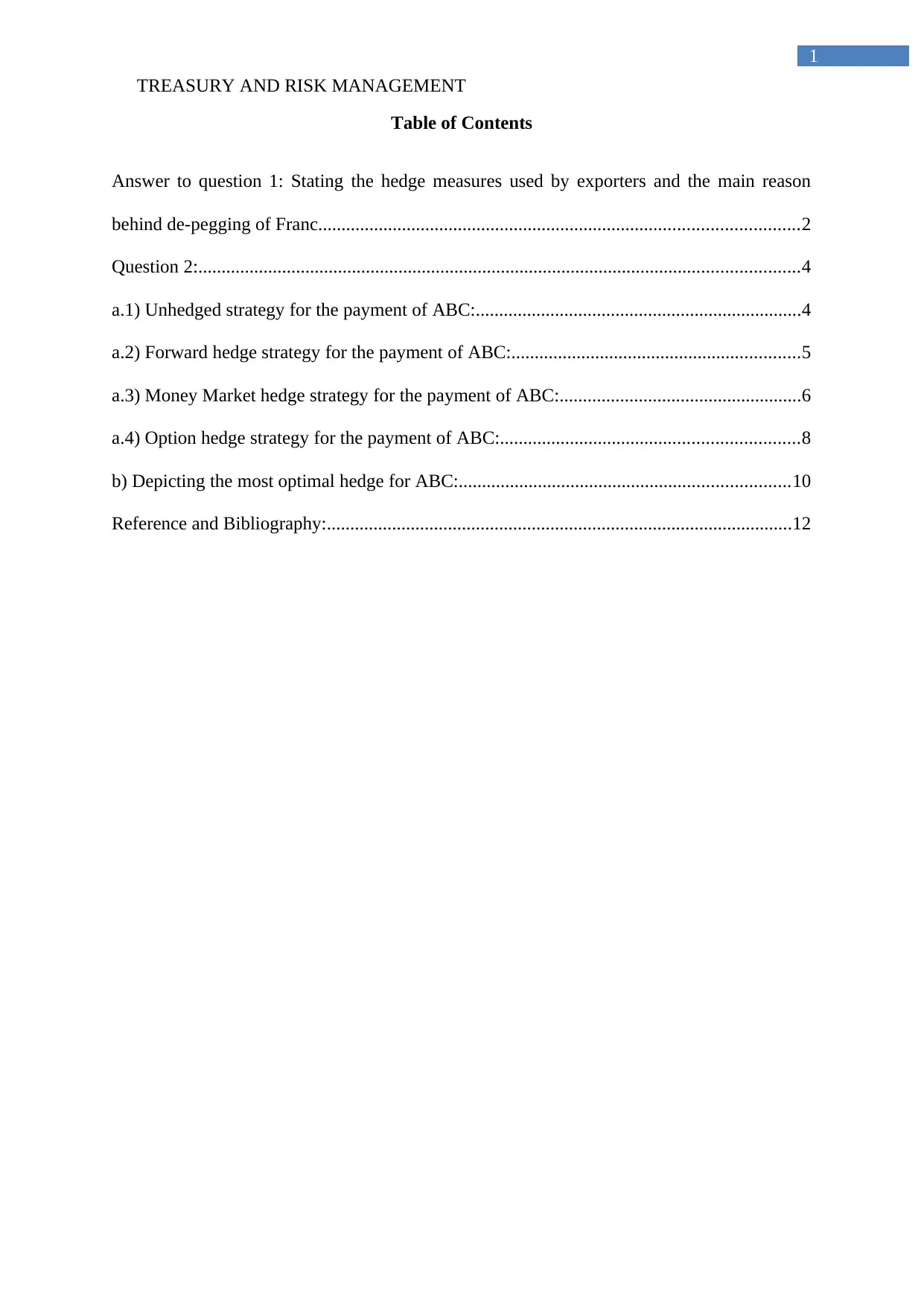
TREASURY AND RISK MANAGEMENT
1
Table of Contents
Answer to question 1: Stating the hedge measures used by exporters and the main reason
behind de-pegging of Franc.......................................................................................................2
Question 2:.................................................................................................................................4
a.1) Unhedged strategy for the payment of ABC:......................................................................4
a.2) Forward hedge strategy for the payment of ABC:..............................................................5
a.3) Money Market hedge strategy for the payment of ABC:....................................................6
a.4) Option hedge strategy for the payment of ABC:................................................................8
b) Depicting the most optimal hedge for ABC:.......................................................................10
Reference and Bibliography:....................................................................................................12
1
Table of Contents
Answer to question 1: Stating the hedge measures used by exporters and the main reason
behind de-pegging of Franc.......................................................................................................2
Question 2:.................................................................................................................................4
a.1) Unhedged strategy for the payment of ABC:......................................................................4
a.2) Forward hedge strategy for the payment of ABC:..............................................................5
a.3) Money Market hedge strategy for the payment of ABC:....................................................6
a.4) Option hedge strategy for the payment of ABC:................................................................8
b) Depicting the most optimal hedge for ABC:.......................................................................10
Reference and Bibliography:....................................................................................................12
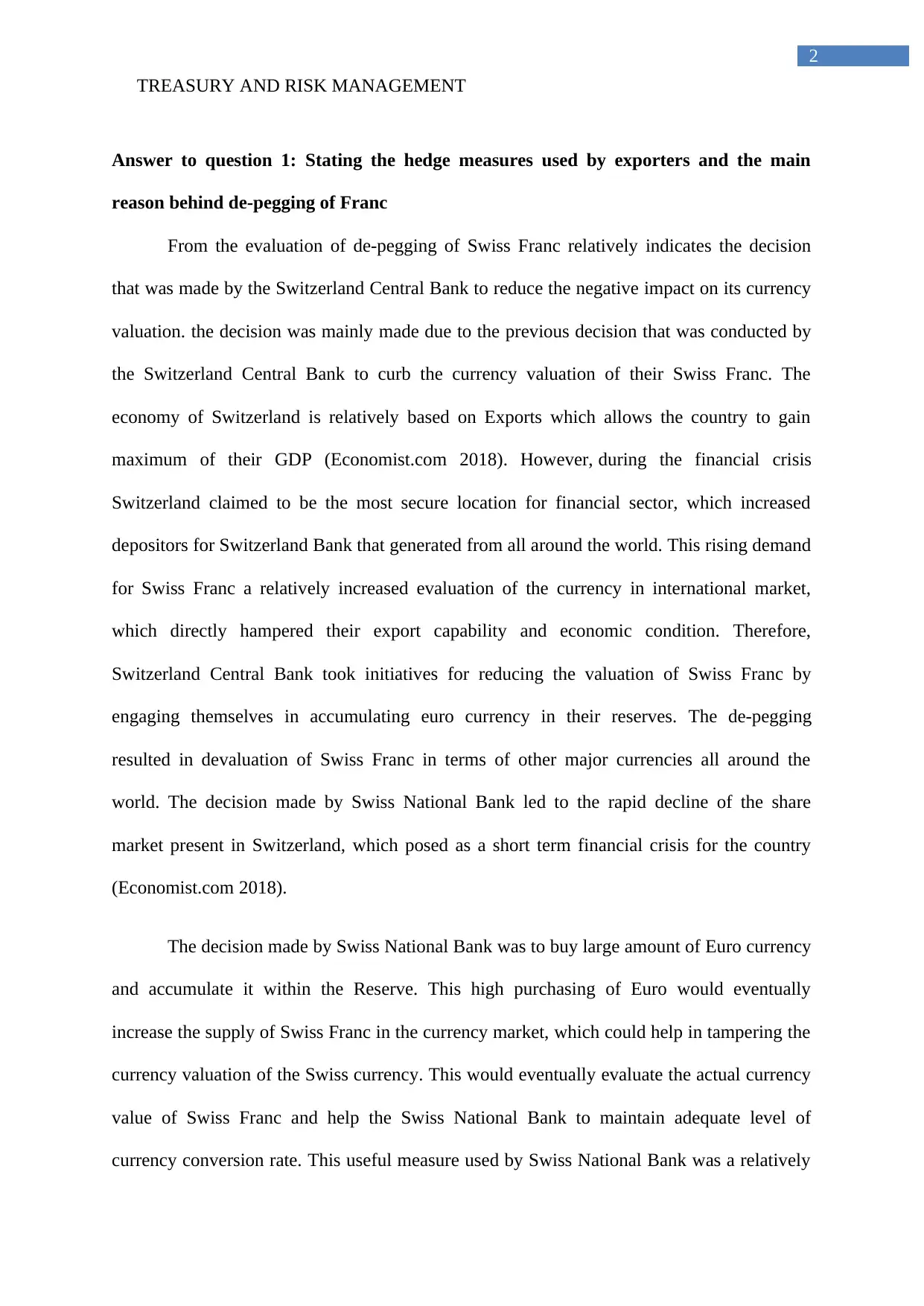
TREASURY AND RISK MANAGEMENT
2
Answer to question 1: Stating the hedge measures used by exporters and the main
reason behind de-pegging of Franc
From the evaluation of de-pegging of Swiss Franc relatively indicates the decision
that was made by the Switzerland Central Bank to reduce the negative impact on its currency
valuation. the decision was mainly made due to the previous decision that was conducted by
the Switzerland Central Bank to curb the currency valuation of their Swiss Franc. The
economy of Switzerland is relatively based on Exports which allows the country to gain
maximum of their GDP (Economist.com 2018). However, during the financial crisis
Switzerland claimed to be the most secure location for financial sector, which increased
depositors for Switzerland Bank that generated from all around the world. This rising demand
for Swiss Franc a relatively increased evaluation of the currency in international market,
which directly hampered their export capability and economic condition. Therefore,
Switzerland Central Bank took initiatives for reducing the valuation of Swiss Franc by
engaging themselves in accumulating euro currency in their reserves. The de-pegging
resulted in devaluation of Swiss Franc in terms of other major currencies all around the
world. The decision made by Swiss National Bank led to the rapid decline of the share
market present in Switzerland, which posed as a short term financial crisis for the country
(Economist.com 2018).
The decision made by Swiss National Bank was to buy large amount of Euro currency
and accumulate it within the Reserve. This high purchasing of Euro would eventually
increase the supply of Swiss Franc in the currency market, which could help in tampering the
currency valuation of the Swiss currency. This would eventually evaluate the actual currency
value of Swiss Franc and help the Swiss National Bank to maintain adequate level of
currency conversion rate. This useful measure used by Swiss National Bank was a relatively
2
Answer to question 1: Stating the hedge measures used by exporters and the main
reason behind de-pegging of Franc
From the evaluation of de-pegging of Swiss Franc relatively indicates the decision
that was made by the Switzerland Central Bank to reduce the negative impact on its currency
valuation. the decision was mainly made due to the previous decision that was conducted by
the Switzerland Central Bank to curb the currency valuation of their Swiss Franc. The
economy of Switzerland is relatively based on Exports which allows the country to gain
maximum of their GDP (Economist.com 2018). However, during the financial crisis
Switzerland claimed to be the most secure location for financial sector, which increased
depositors for Switzerland Bank that generated from all around the world. This rising demand
for Swiss Franc a relatively increased evaluation of the currency in international market,
which directly hampered their export capability and economic condition. Therefore,
Switzerland Central Bank took initiatives for reducing the valuation of Swiss Franc by
engaging themselves in accumulating euro currency in their reserves. The de-pegging
resulted in devaluation of Swiss Franc in terms of other major currencies all around the
world. The decision made by Swiss National Bank led to the rapid decline of the share
market present in Switzerland, which posed as a short term financial crisis for the country
(Economist.com 2018).
The decision made by Swiss National Bank was to buy large amount of Euro currency
and accumulate it within the Reserve. This high purchasing of Euro would eventually
increase the supply of Swiss Franc in the currency market, which could help in tampering the
currency valuation of the Swiss currency. This would eventually evaluate the actual currency
value of Swiss Franc and help the Swiss National Bank to maintain adequate level of
currency conversion rate. This useful measure used by Swiss National Bank was a relatively
⊘ This is a preview!⊘
Do you want full access?
Subscribe today to unlock all pages.

Trusted by 1+ million students worldwide
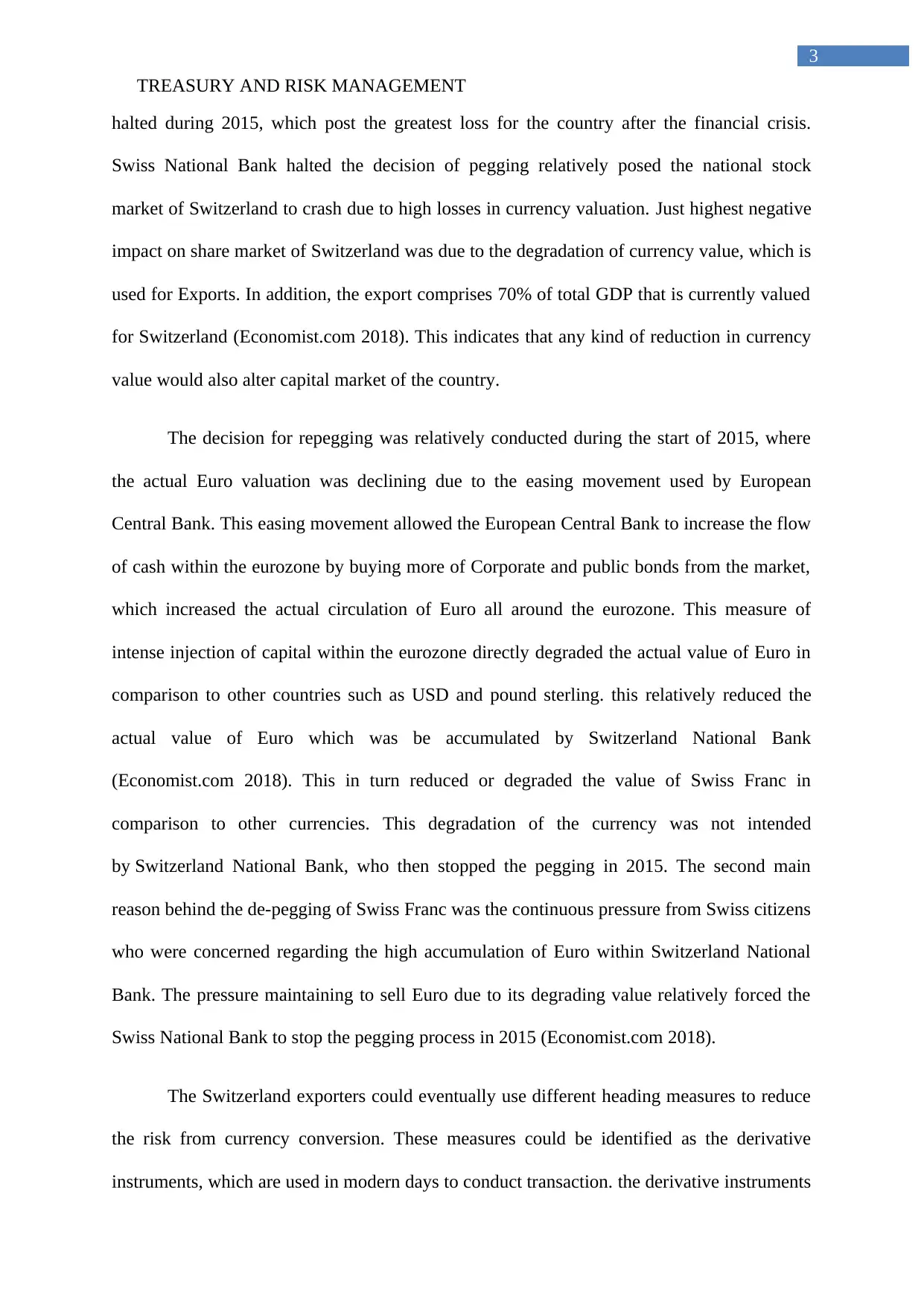
TREASURY AND RISK MANAGEMENT
3
halted during 2015, which post the greatest loss for the country after the financial crisis.
Swiss National Bank halted the decision of pegging relatively posed the national stock
market of Switzerland to crash due to high losses in currency valuation. Just highest negative
impact on share market of Switzerland was due to the degradation of currency value, which is
used for Exports. In addition, the export comprises 70% of total GDP that is currently valued
for Switzerland (Economist.com 2018). This indicates that any kind of reduction in currency
value would also alter capital market of the country.
The decision for repegging was relatively conducted during the start of 2015, where
the actual Euro valuation was declining due to the easing movement used by European
Central Bank. This easing movement allowed the European Central Bank to increase the flow
of cash within the eurozone by buying more of Corporate and public bonds from the market,
which increased the actual circulation of Euro all around the eurozone. This measure of
intense injection of capital within the eurozone directly degraded the actual value of Euro in
comparison to other countries such as USD and pound sterling. this relatively reduced the
actual value of Euro which was be accumulated by Switzerland National Bank
(Economist.com 2018). This in turn reduced or degraded the value of Swiss Franc in
comparison to other currencies. This degradation of the currency was not intended
by Switzerland National Bank, who then stopped the pegging in 2015. The second main
reason behind the de-pegging of Swiss Franc was the continuous pressure from Swiss citizens
who were concerned regarding the high accumulation of Euro within Switzerland National
Bank. The pressure maintaining to sell Euro due to its degrading value relatively forced the
Swiss National Bank to stop the pegging process in 2015 (Economist.com 2018).
The Switzerland exporters could eventually use different heading measures to reduce
the risk from currency conversion. These measures could be identified as the derivative
instruments, which are used in modern days to conduct transaction. the derivative instruments
3
halted during 2015, which post the greatest loss for the country after the financial crisis.
Swiss National Bank halted the decision of pegging relatively posed the national stock
market of Switzerland to crash due to high losses in currency valuation. Just highest negative
impact on share market of Switzerland was due to the degradation of currency value, which is
used for Exports. In addition, the export comprises 70% of total GDP that is currently valued
for Switzerland (Economist.com 2018). This indicates that any kind of reduction in currency
value would also alter capital market of the country.
The decision for repegging was relatively conducted during the start of 2015, where
the actual Euro valuation was declining due to the easing movement used by European
Central Bank. This easing movement allowed the European Central Bank to increase the flow
of cash within the eurozone by buying more of Corporate and public bonds from the market,
which increased the actual circulation of Euro all around the eurozone. This measure of
intense injection of capital within the eurozone directly degraded the actual value of Euro in
comparison to other countries such as USD and pound sterling. this relatively reduced the
actual value of Euro which was be accumulated by Switzerland National Bank
(Economist.com 2018). This in turn reduced or degraded the value of Swiss Franc in
comparison to other currencies. This degradation of the currency was not intended
by Switzerland National Bank, who then stopped the pegging in 2015. The second main
reason behind the de-pegging of Swiss Franc was the continuous pressure from Swiss citizens
who were concerned regarding the high accumulation of Euro within Switzerland National
Bank. The pressure maintaining to sell Euro due to its degrading value relatively forced the
Swiss National Bank to stop the pegging process in 2015 (Economist.com 2018).
The Switzerland exporters could eventually use different heading measures to reduce
the risk from currency conversion. These measures could be identified as the derivative
instruments, which are used in modern days to conduct transaction. the derivative instruments
Paraphrase This Document
Need a fresh take? Get an instant paraphrase of this document with our AI Paraphraser
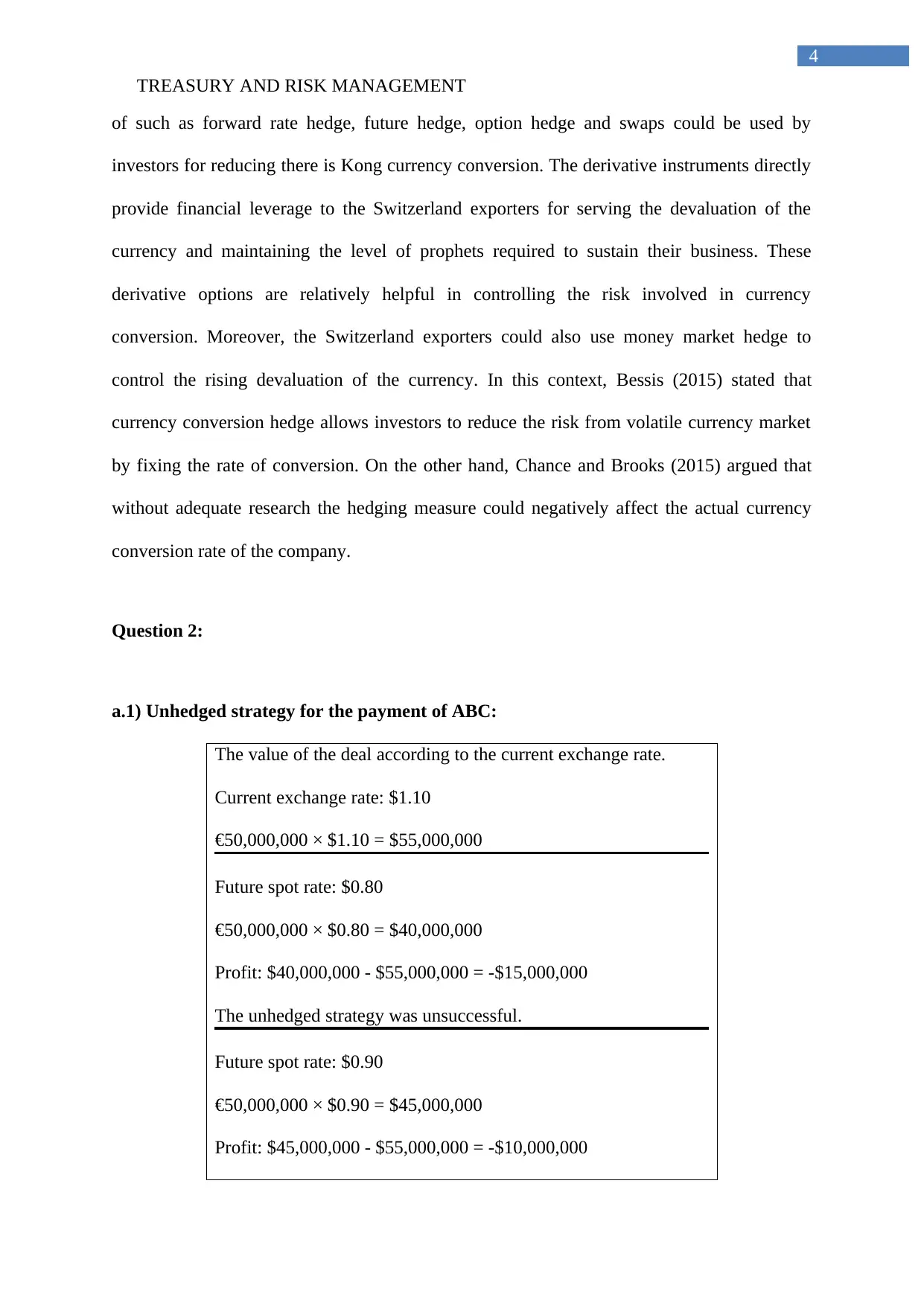
TREASURY AND RISK MANAGEMENT
4
of such as forward rate hedge, future hedge, option hedge and swaps could be used by
investors for reducing there is Kong currency conversion. The derivative instruments directly
provide financial leverage to the Switzerland exporters for serving the devaluation of the
currency and maintaining the level of prophets required to sustain their business. These
derivative options are relatively helpful in controlling the risk involved in currency
conversion. Moreover, the Switzerland exporters could also use money market hedge to
control the rising devaluation of the currency. In this context, Bessis (2015) stated that
currency conversion hedge allows investors to reduce the risk from volatile currency market
by fixing the rate of conversion. On the other hand, Chance and Brooks (2015) argued that
without adequate research the hedging measure could negatively affect the actual currency
conversion rate of the company.
Question 2:
a.1) Unhedged strategy for the payment of ABC:
The value of the deal according to the current exchange rate.
Current exchange rate: $1.10
€50,000,000 × $1.10 = $55,000,000
Future spot rate: $0.80
€50,000,000 × $0.80 = $40,000,000
Profit: $40,000,000 - $55,000,000 = -$15,000,000
The unhedged strategy was unsuccessful.
Future spot rate: $0.90
€50,000,000 × $0.90 = $45,000,000
Profit: $45,000,000 - $55,000,000 = -$10,000,000
4
of such as forward rate hedge, future hedge, option hedge and swaps could be used by
investors for reducing there is Kong currency conversion. The derivative instruments directly
provide financial leverage to the Switzerland exporters for serving the devaluation of the
currency and maintaining the level of prophets required to sustain their business. These
derivative options are relatively helpful in controlling the risk involved in currency
conversion. Moreover, the Switzerland exporters could also use money market hedge to
control the rising devaluation of the currency. In this context, Bessis (2015) stated that
currency conversion hedge allows investors to reduce the risk from volatile currency market
by fixing the rate of conversion. On the other hand, Chance and Brooks (2015) argued that
without adequate research the hedging measure could negatively affect the actual currency
conversion rate of the company.
Question 2:
a.1) Unhedged strategy for the payment of ABC:
The value of the deal according to the current exchange rate.
Current exchange rate: $1.10
€50,000,000 × $1.10 = $55,000,000
Future spot rate: $0.80
€50,000,000 × $0.80 = $40,000,000
Profit: $40,000,000 - $55,000,000 = -$15,000,000
The unhedged strategy was unsuccessful.
Future spot rate: $0.90
€50,000,000 × $0.90 = $45,000,000
Profit: $45,000,000 - $55,000,000 = -$10,000,000
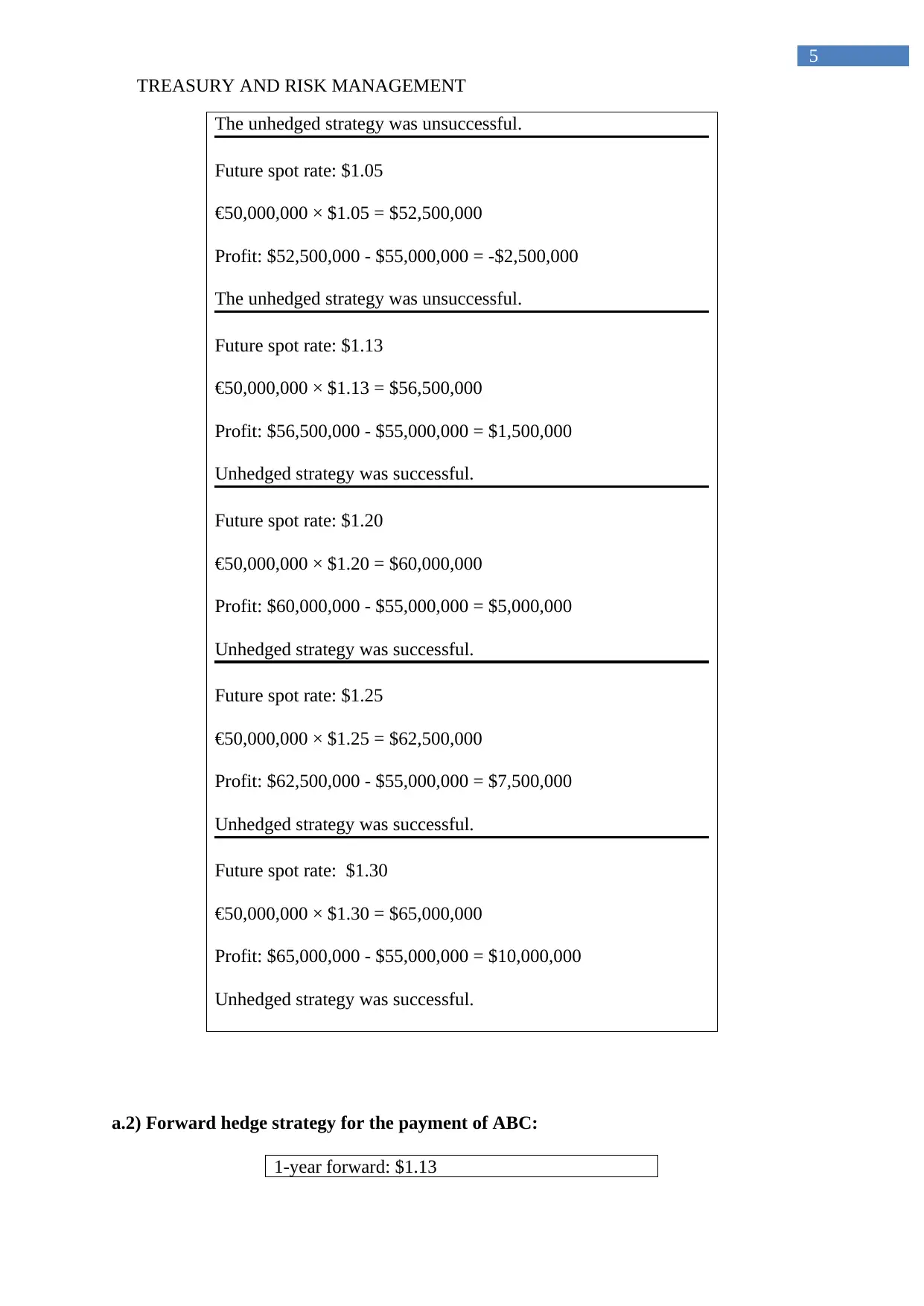
TREASURY AND RISK MANAGEMENT
5
The unhedged strategy was unsuccessful.
Future spot rate: $1.05
€50,000,000 × $1.05 = $52,500,000
Profit: $52,500,000 - $55,000,000 = -$2,500,000
The unhedged strategy was unsuccessful.
Future spot rate: $1.13
€50,000,000 × $1.13 = $56,500,000
Profit: $56,500,000 - $55,000,000 = $1,500,000
Unhedged strategy was successful.
Future spot rate: $1.20
€50,000,000 × $1.20 = $60,000,000
Profit: $60,000,000 - $55,000,000 = $5,000,000
Unhedged strategy was successful.
Future spot rate: $1.25
€50,000,000 × $1.25 = $62,500,000
Profit: $62,500,000 - $55,000,000 = $7,500,000
Unhedged strategy was successful.
Future spot rate: $1.30
€50,000,000 × $1.30 = $65,000,000
Profit: $65,000,000 - $55,000,000 = $10,000,000
Unhedged strategy was successful.
a.2) Forward hedge strategy for the payment of ABC:
1-year forward: $1.13
5
The unhedged strategy was unsuccessful.
Future spot rate: $1.05
€50,000,000 × $1.05 = $52,500,000
Profit: $52,500,000 - $55,000,000 = -$2,500,000
The unhedged strategy was unsuccessful.
Future spot rate: $1.13
€50,000,000 × $1.13 = $56,500,000
Profit: $56,500,000 - $55,000,000 = $1,500,000
Unhedged strategy was successful.
Future spot rate: $1.20
€50,000,000 × $1.20 = $60,000,000
Profit: $60,000,000 - $55,000,000 = $5,000,000
Unhedged strategy was successful.
Future spot rate: $1.25
€50,000,000 × $1.25 = $62,500,000
Profit: $62,500,000 - $55,000,000 = $7,500,000
Unhedged strategy was successful.
Future spot rate: $1.30
€50,000,000 × $1.30 = $65,000,000
Profit: $65,000,000 - $55,000,000 = $10,000,000
Unhedged strategy was successful.
a.2) Forward hedge strategy for the payment of ABC:
1-year forward: $1.13
⊘ This is a preview!⊘
Do you want full access?
Subscribe today to unlock all pages.

Trusted by 1+ million students worldwide
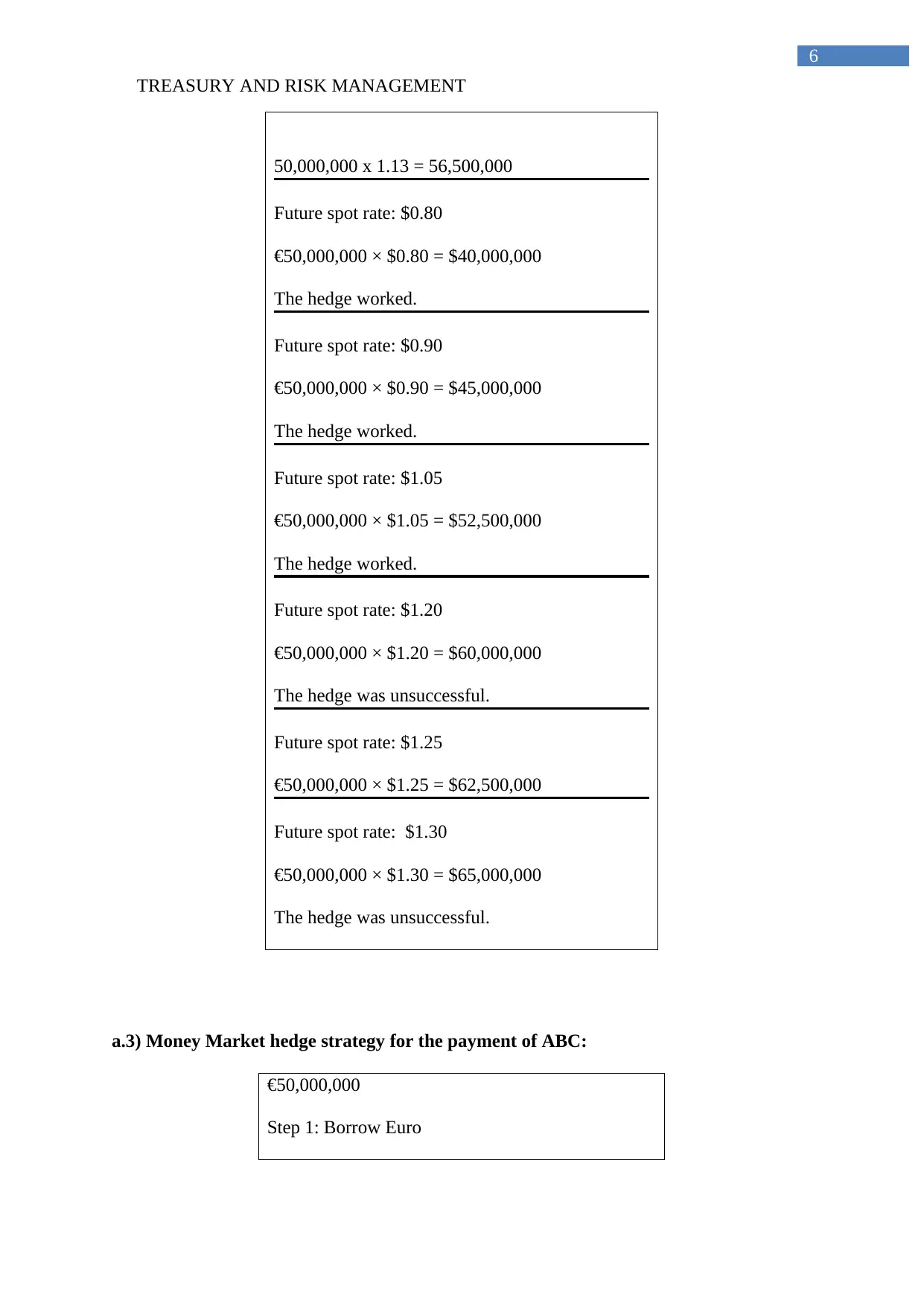
TREASURY AND RISK MANAGEMENT
6
50,000,000 x 1.13 = 56,500,000
Future spot rate: $0.80
€50,000,000 × $0.80 = $40,000,000
The hedge worked.
Future spot rate: $0.90
€50,000,000 × $0.90 = $45,000,000
The hedge worked.
Future spot rate: $1.05
€50,000,000 × $1.05 = $52,500,000
The hedge worked.
Future spot rate: $1.20
€50,000,000 × $1.20 = $60,000,000
The hedge was unsuccessful.
Future spot rate: $1.25
€50,000,000 × $1.25 = $62,500,000
Future spot rate: $1.30
€50,000,000 × $1.30 = $65,000,000
The hedge was unsuccessful.
a.3) Money Market hedge strategy for the payment of ABC:
€50,000,000
Step 1: Borrow Euro
6
50,000,000 x 1.13 = 56,500,000
Future spot rate: $0.80
€50,000,000 × $0.80 = $40,000,000
The hedge worked.
Future spot rate: $0.90
€50,000,000 × $0.90 = $45,000,000
The hedge worked.
Future spot rate: $1.05
€50,000,000 × $1.05 = $52,500,000
The hedge worked.
Future spot rate: $1.20
€50,000,000 × $1.20 = $60,000,000
The hedge was unsuccessful.
Future spot rate: $1.25
€50,000,000 × $1.25 = $62,500,000
Future spot rate: $1.30
€50,000,000 × $1.30 = $65,000,000
The hedge was unsuccessful.
a.3) Money Market hedge strategy for the payment of ABC:
€50,000,000
Step 1: Borrow Euro
Paraphrase This Document
Need a fresh take? Get an instant paraphrase of this document with our AI Paraphraser
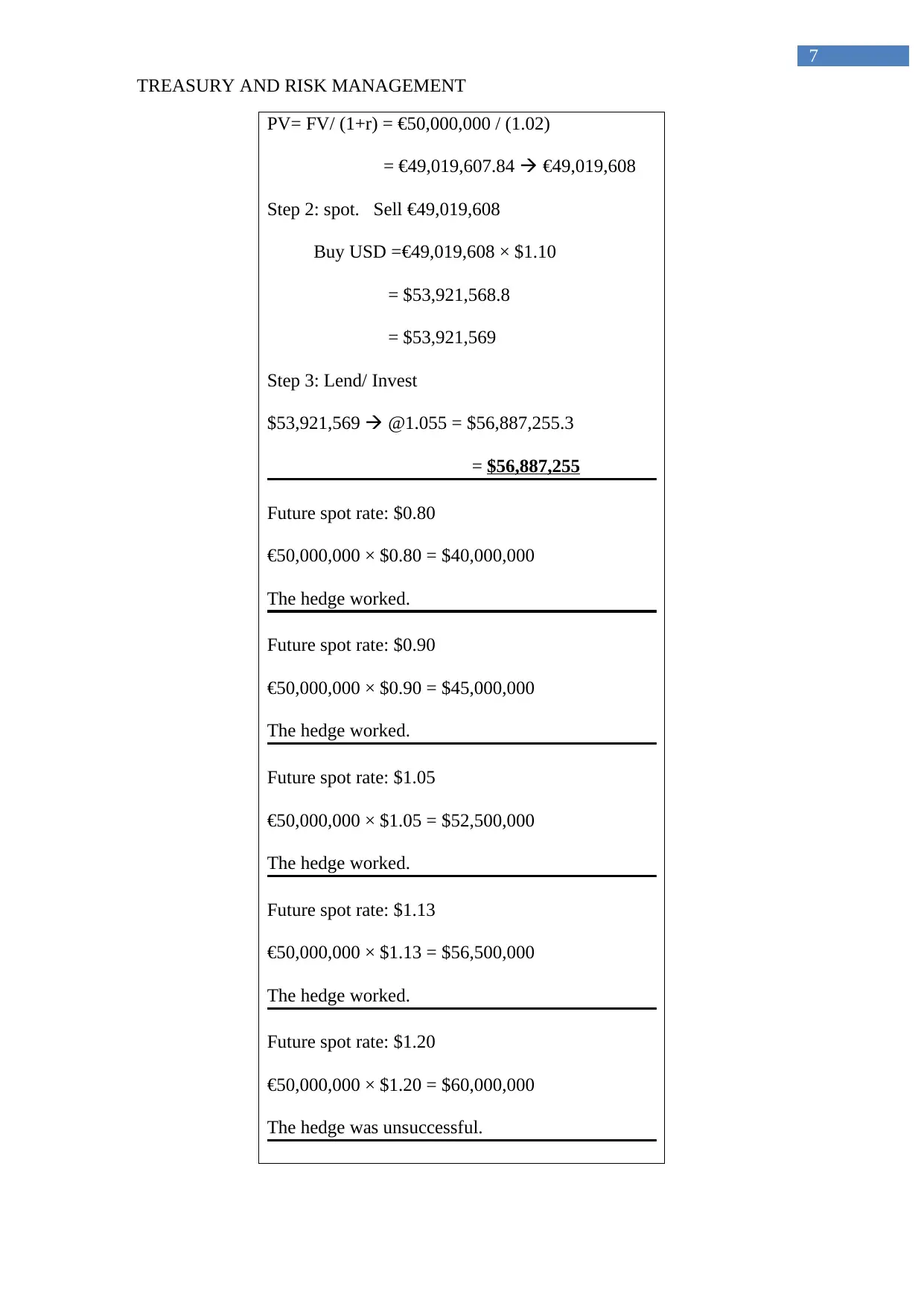
TREASURY AND RISK MANAGEMENT
7
PV= FV/ (1+r) = €50,000,000 / (1.02)
= €49,019,607.84 €49,019,608
Step 2: spot. Sell €49,019,608
Buy USD =€49,019,608 × $1.10
= $53,921,568.8
= $53,921,569
Step 3: Lend/ Invest
$53,921,569 @1.055 = $56,887,255.3
= $56,887,255
Future spot rate: $0.80
€50,000,000 × $0.80 = $40,000,000
The hedge worked.
Future spot rate: $0.90
€50,000,000 × $0.90 = $45,000,000
The hedge worked.
Future spot rate: $1.05
€50,000,000 × $1.05 = $52,500,000
The hedge worked.
Future spot rate: $1.13
€50,000,000 × $1.13 = $56,500,000
The hedge worked.
Future spot rate: $1.20
€50,000,000 × $1.20 = $60,000,000
The hedge was unsuccessful.
7
PV= FV/ (1+r) = €50,000,000 / (1.02)
= €49,019,607.84 €49,019,608
Step 2: spot. Sell €49,019,608
Buy USD =€49,019,608 × $1.10
= $53,921,568.8
= $53,921,569
Step 3: Lend/ Invest
$53,921,569 @1.055 = $56,887,255.3
= $56,887,255
Future spot rate: $0.80
€50,000,000 × $0.80 = $40,000,000
The hedge worked.
Future spot rate: $0.90
€50,000,000 × $0.90 = $45,000,000
The hedge worked.
Future spot rate: $1.05
€50,000,000 × $1.05 = $52,500,000
The hedge worked.
Future spot rate: $1.13
€50,000,000 × $1.13 = $56,500,000
The hedge worked.
Future spot rate: $1.20
€50,000,000 × $1.20 = $60,000,000
The hedge was unsuccessful.
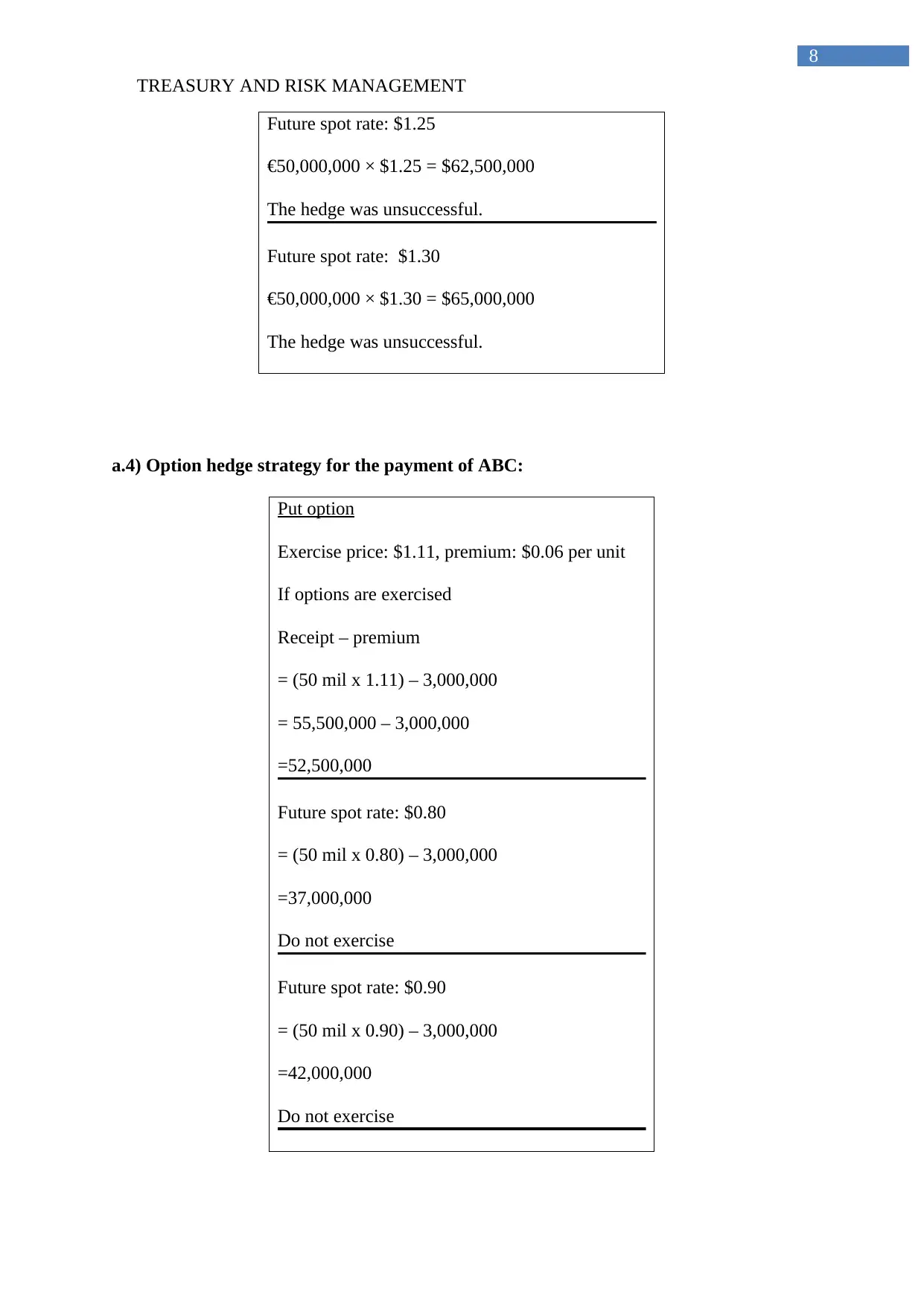
TREASURY AND RISK MANAGEMENT
8
Future spot rate: $1.25
€50,000,000 × $1.25 = $62,500,000
The hedge was unsuccessful.
Future spot rate: $1.30
€50,000,000 × $1.30 = $65,000,000
The hedge was unsuccessful.
a.4) Option hedge strategy for the payment of ABC:
Put option
Exercise price: $1.11, premium: $0.06 per unit
If options are exercised
Receipt – premium
= (50 mil x 1.11) – 3,000,000
= 55,500,000 – 3,000,000
=52,500,000
Future spot rate: $0.80
= (50 mil x 0.80) – 3,000,000
=37,000,000
Do not exercise
Future spot rate: $0.90
= (50 mil x 0.90) – 3,000,000
=42,000,000
Do not exercise
8
Future spot rate: $1.25
€50,000,000 × $1.25 = $62,500,000
The hedge was unsuccessful.
Future spot rate: $1.30
€50,000,000 × $1.30 = $65,000,000
The hedge was unsuccessful.
a.4) Option hedge strategy for the payment of ABC:
Put option
Exercise price: $1.11, premium: $0.06 per unit
If options are exercised
Receipt – premium
= (50 mil x 1.11) – 3,000,000
= 55,500,000 – 3,000,000
=52,500,000
Future spot rate: $0.80
= (50 mil x 0.80) – 3,000,000
=37,000,000
Do not exercise
Future spot rate: $0.90
= (50 mil x 0.90) – 3,000,000
=42,000,000
Do not exercise
⊘ This is a preview!⊘
Do you want full access?
Subscribe today to unlock all pages.

Trusted by 1+ million students worldwide
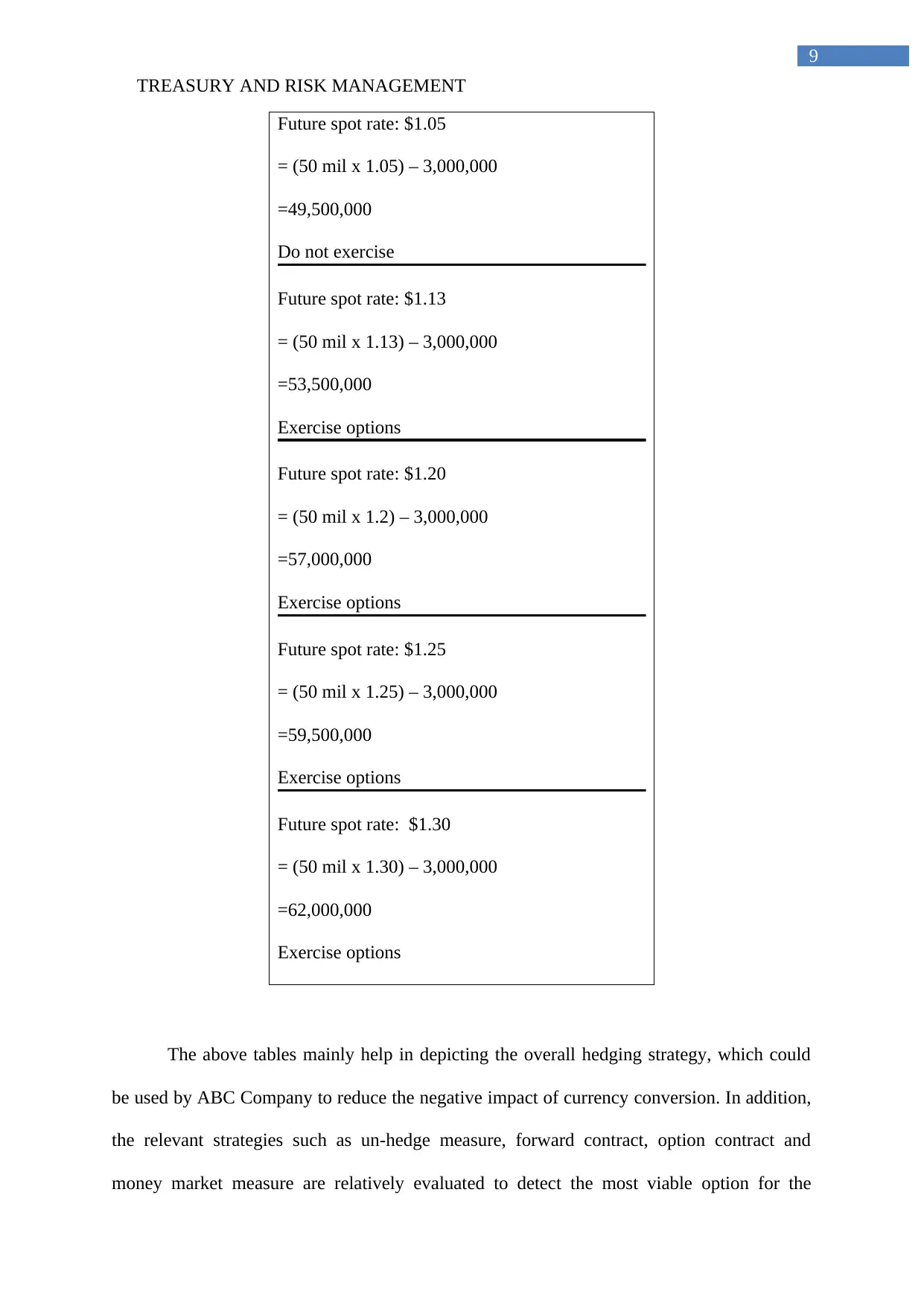
TREASURY AND RISK MANAGEMENT
9
Future spot rate: $1.05
= (50 mil x 1.05) – 3,000,000
=49,500,000
Do not exercise
Future spot rate: $1.13
= (50 mil x 1.13) – 3,000,000
=53,500,000
Exercise options
Future spot rate: $1.20
= (50 mil x 1.2) – 3,000,000
=57,000,000
Exercise options
Future spot rate: $1.25
= (50 mil x 1.25) – 3,000,000
=59,500,000
Exercise options
Future spot rate: $1.30
= (50 mil x 1.30) – 3,000,000
=62,000,000
Exercise options
The above tables mainly help in depicting the overall hedging strategy, which could
be used by ABC Company to reduce the negative impact of currency conversion. In addition,
the relevant strategies such as un-hedge measure, forward contract, option contract and
money market measure are relatively evaluated to detect the most viable option for the
9
Future spot rate: $1.05
= (50 mil x 1.05) – 3,000,000
=49,500,000
Do not exercise
Future spot rate: $1.13
= (50 mil x 1.13) – 3,000,000
=53,500,000
Exercise options
Future spot rate: $1.20
= (50 mil x 1.2) – 3,000,000
=57,000,000
Exercise options
Future spot rate: $1.25
= (50 mil x 1.25) – 3,000,000
=59,500,000
Exercise options
Future spot rate: $1.30
= (50 mil x 1.30) – 3,000,000
=62,000,000
Exercise options
The above tables mainly help in depicting the overall hedging strategy, which could
be used by ABC Company to reduce the negative impact of currency conversion. In addition,
the relevant strategies such as un-hedge measure, forward contract, option contract and
money market measure are relatively evaluated to detect the most viable option for the
Paraphrase This Document
Need a fresh take? Get an instant paraphrase of this document with our AI Paraphraser
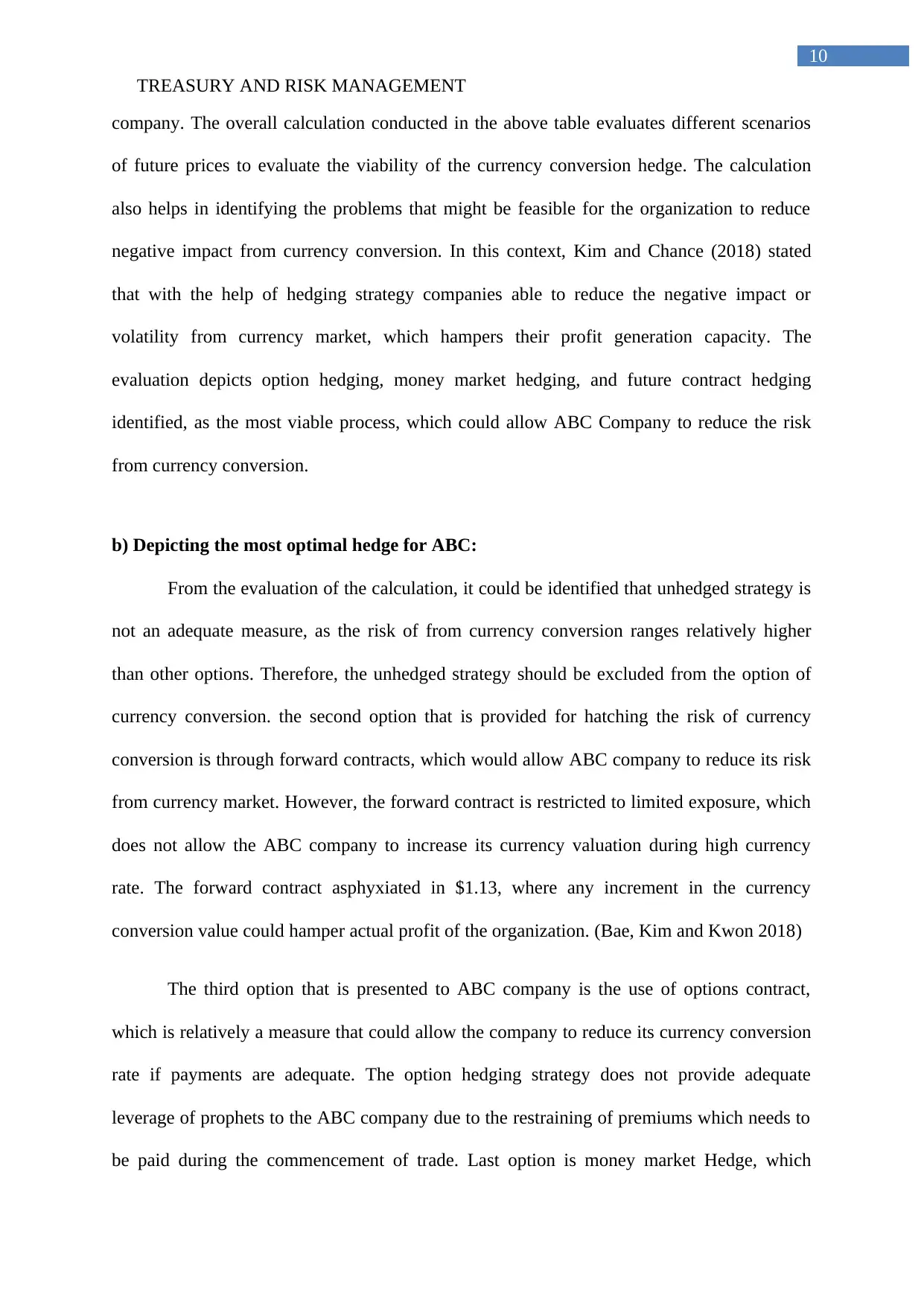
TREASURY AND RISK MANAGEMENT
10
company. The overall calculation conducted in the above table evaluates different scenarios
of future prices to evaluate the viability of the currency conversion hedge. The calculation
also helps in identifying the problems that might be feasible for the organization to reduce
negative impact from currency conversion. In this context, Kim and Chance (2018) stated
that with the help of hedging strategy companies able to reduce the negative impact or
volatility from currency market, which hampers their profit generation capacity. The
evaluation depicts option hedging, money market hedging, and future contract hedging
identified, as the most viable process, which could allow ABC Company to reduce the risk
from currency conversion.
b) Depicting the most optimal hedge for ABC:
From the evaluation of the calculation, it could be identified that unhedged strategy is
not an adequate measure, as the risk of from currency conversion ranges relatively higher
than other options. Therefore, the unhedged strategy should be excluded from the option of
currency conversion. the second option that is provided for hatching the risk of currency
conversion is through forward contracts, which would allow ABC company to reduce its risk
from currency market. However, the forward contract is restricted to limited exposure, which
does not allow the ABC company to increase its currency valuation during high currency
rate. The forward contract asphyxiated in $1.13, where any increment in the currency
conversion value could hamper actual profit of the organization. (Bae, Kim and Kwon 2018)
The third option that is presented to ABC company is the use of options contract,
which is relatively a measure that could allow the company to reduce its currency conversion
rate if payments are adequate. The option hedging strategy does not provide adequate
leverage of prophets to the ABC company due to the restraining of premiums which needs to
be paid during the commencement of trade. Last option is money market Hedge, which
10
company. The overall calculation conducted in the above table evaluates different scenarios
of future prices to evaluate the viability of the currency conversion hedge. The calculation
also helps in identifying the problems that might be feasible for the organization to reduce
negative impact from currency conversion. In this context, Kim and Chance (2018) stated
that with the help of hedging strategy companies able to reduce the negative impact or
volatility from currency market, which hampers their profit generation capacity. The
evaluation depicts option hedging, money market hedging, and future contract hedging
identified, as the most viable process, which could allow ABC Company to reduce the risk
from currency conversion.
b) Depicting the most optimal hedge for ABC:
From the evaluation of the calculation, it could be identified that unhedged strategy is
not an adequate measure, as the risk of from currency conversion ranges relatively higher
than other options. Therefore, the unhedged strategy should be excluded from the option of
currency conversion. the second option that is provided for hatching the risk of currency
conversion is through forward contracts, which would allow ABC company to reduce its risk
from currency market. However, the forward contract is restricted to limited exposure, which
does not allow the ABC company to increase its currency valuation during high currency
rate. The forward contract asphyxiated in $1.13, where any increment in the currency
conversion value could hamper actual profit of the organization. (Bae, Kim and Kwon 2018)
The third option that is presented to ABC company is the use of options contract,
which is relatively a measure that could allow the company to reduce its currency conversion
rate if payments are adequate. The option hedging strategy does not provide adequate
leverage of prophets to the ABC company due to the restraining of premiums which needs to
be paid during the commencement of trade. Last option is money market Hedge, which
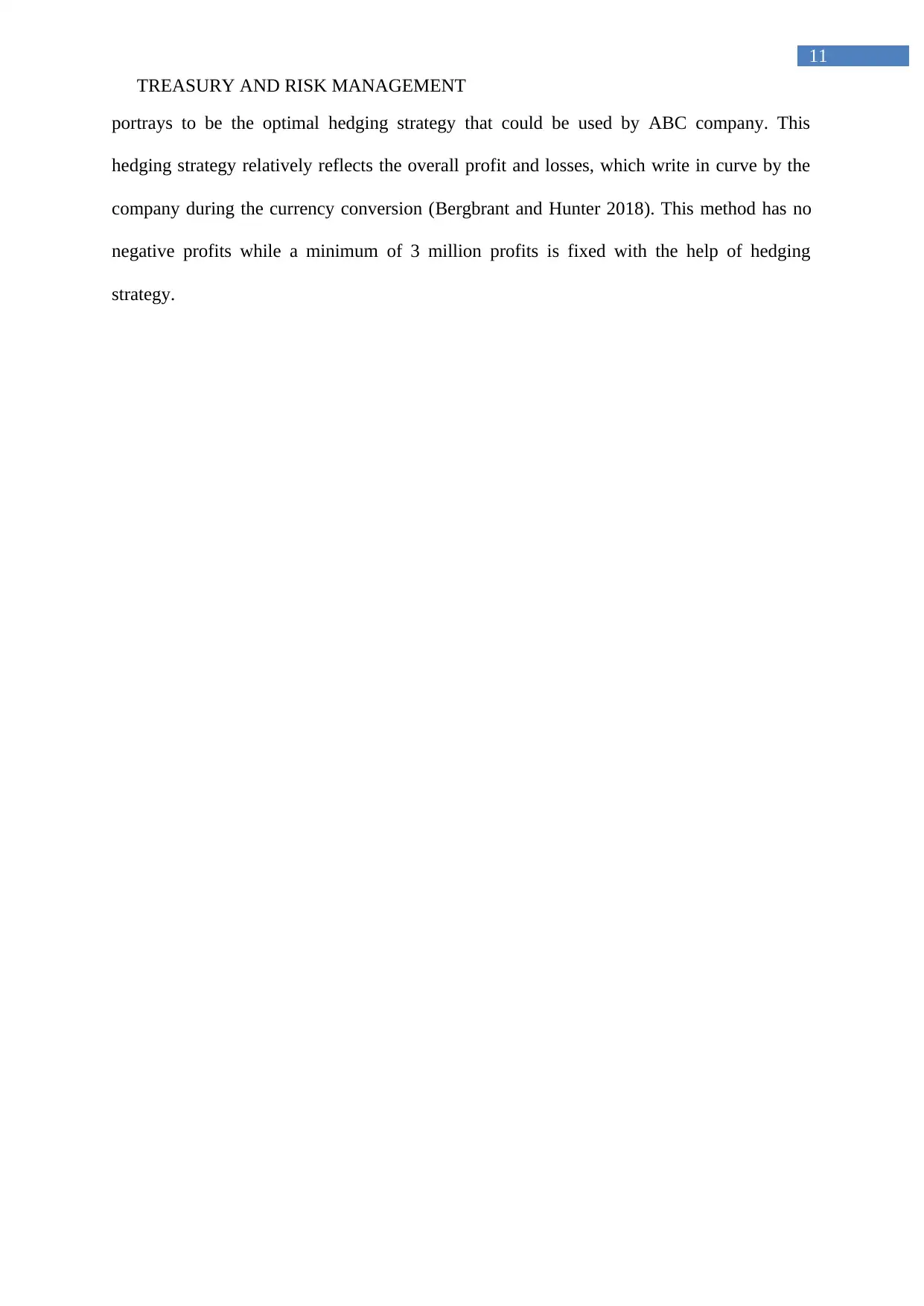
TREASURY AND RISK MANAGEMENT
11
portrays to be the optimal hedging strategy that could be used by ABC company. This
hedging strategy relatively reflects the overall profit and losses, which write in curve by the
company during the currency conversion (Bergbrant and Hunter 2018). This method has no
negative profits while a minimum of 3 million profits is fixed with the help of hedging
strategy.
11
portrays to be the optimal hedging strategy that could be used by ABC company. This
hedging strategy relatively reflects the overall profit and losses, which write in curve by the
company during the currency conversion (Bergbrant and Hunter 2018). This method has no
negative profits while a minimum of 3 million profits is fixed with the help of hedging
strategy.
⊘ This is a preview!⊘
Do you want full access?
Subscribe today to unlock all pages.

Trusted by 1+ million students worldwide
1 out of 14
Related Documents
Your All-in-One AI-Powered Toolkit for Academic Success.
+13062052269
info@desklib.com
Available 24*7 on WhatsApp / Email
![[object Object]](/_next/static/media/star-bottom.7253800d.svg)
Unlock your academic potential
Copyright © 2020–2025 A2Z Services. All Rights Reserved. Developed and managed by ZUCOL.





